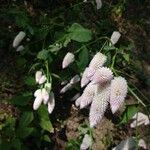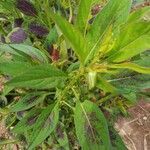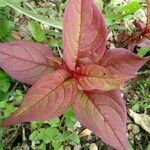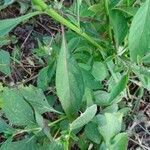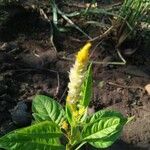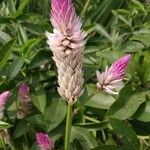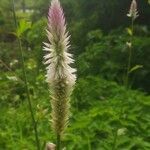Forma spontanea: Annual, 0.4-1½ m; stem erect, green or red, strongly ribbed, often much branched. Leaves on petioles of ¼-1¾ cm or highest almost sessile, oblong-lanceolate or lanceolate-linear, rarely ovate-oblong, acute at both ends, herbaceous, often tinged with red, 4-18 by ¾-5½ cm; highest often very small; leaf axils often provided with ± falcate small leaves. Spikes solitary or sometimes paired, erect, stalked or partly subsessile, often much lengthening during anthesis, at length cylindrical with a conical apex, very dense, throughout their length (when pure-bred) with ☿flowers, usually simple, sometimes bifid or trifid at apex, 2-22 by 1-1¾ cm; their stalk ribbed-furrowed, often lengthening during anthe-sis, finally ½-21 cm. Flowers solitary, sessile, obliquely patent; bracts and bracteoles persistent after fall of the perianth, ovate-oblong, pellucid, 1-nerved, mucronate, 3-7 mm long. Perianth 6-10 mm, at first shining white with a pink tip or almost entirely pink, withering white. Adult staminal cup 1¼-2 mm high; free part of filaments 2½-3 mm; pseudo-staminodes minute, triangular. Style violet, 3¼-5 mm. Utricle included by the perianth, obo-void with rounded apex, ± 3½ mm long. Seeds 1-9, 1¼-1½ mm diam.
Annual herb to 1(-2) m, often smaller, sometimes woody at base, glabrous; stems ascending, simple or branched, longitudinally angled. Petiole 0.1-7.0 cm long; blade linear-lanceolate, lance-ovate, lance-elliptic, lanceolate or linear, 2-20 x 0.1-6.0 cm, obtuse to acuminate, sometimes mucronulate, decurrent on petiole. Inflorescence of terminal and upper leaf-axils, densely flowered, up to 12 cm long pedunculate spikes of 2.5-30.0 x 0.7-2.4 cm; bract chaffy, linear, lanceolate or ovate, 2-7 mm long; bracteoles ovate-lanceolate, hyaline, subequal, shorter than bracts; pedicels less than 1 mm long; uppermost flowers occasionally sterile. Tepals lanceolate or elliptic-oblong, 5-11 mm long, acute, scarious-translucent, silvery white to pink, 2-to 5-veined in middle, margin hyaline; stamens cream or pinkish, 3-5 mm long, free filaments longer than fused staminal cup; ovules (1-)3-9, style filiform, 4-8 mm long, stigmas subcapitate, 2-or 3-lobed at apex. Capsule pyriform, ovoid or subglobose, 3-5 mm long; seeds cochleate-orbicular, lenticular, 1.2-2.0 mm wide, black or dark reddish-brown, shining, minutely reticulate or nearly smooth.
Erect glabrous simple or much branched annuals to 1 m. high. Leaves glabrous, linear-lanceolate to rhombic or ovate, apically acuminate to acute, 3-12 cm. long, 0.5-6 cm. broad; petioles 1-30 mm. long. Inflorescence of simple (quite complex, often fasciated, in cultivated varieties) pedunculate cylindric spikes 2-20 cm. long, 1-2 cm. broad. Flowers perfect, the uppermost occasionally sterile, sessile; bracts and bracteoles subequal, ovate, mucronate, 2-7 mm. long; sepals 5, subequal, ovate, concave, mucronate, white to pinkish (variously colored in cultivated varieties), erect in fruit, 6-10 mm. long; stamens 5, 3-5 mm. long, the tube shorter than the free portions of the filaments; pseudostaminodia minute and deltoid or absent; anthers oblong; ovary ellipsoid; style 1, 3-6 mm. long, usually exceeding the sepals; stigmata 2 (-3), minute. Fruit a circumscissile capsule, shorter than the calyx, 3-4 mm. long; seeds (1-) 3-6 (-9), cochleate-orbiculate, dark reddish brown, about 1.5 mm. broad.
Herb, annual, erect, glabrous, up to 120 cm high. Leaves: petiole 2–15 (–30) mm long; lamina lanceolate, narrowly-elliptic to elliptic, ovate or obovate, 12–100 mm long including petiole, 2–20(–43) mm wide, entire, attenuate into a slender petiole, mucronate. Inflorescence a dense terminal spike, conical to cylindrical, 26–135 (–355) mm long, 12–20 mm wide, many-flowered; peduncle 2–185 (–300) mm long. Bracts and bracteoles lanceolate, 3–6 mm long, 1–1.8 mm wide, acuminate or aristate; midrib prominent. Flowers sessile, deciduous. Tepals narrowly elliptic to lanceolate, 6.8–9 mm long, 1.8–2.5 mm wide, acute or mucronate, 3-nerved, pink fading to white. Stamens united for c. ½ of length; pseudostaminodes 5, minute. Style 4.2–5 mm long; stigma 2-lobed. Fruit circumscissile about half way, ovoid, 3.5–4.2 mm long, 2–3 mm wide. Seeds 4–12, 1.1–1.4 mm long.
Herbs annual, 30-100 cm tall. Stem erect, green or red, glabrous, often branched. Leaves green, often tinged red; petiole absent to 1.5 cm; leaf blade oblong-lanceolate, lanceolate, or lanceolate-linear, rarely ovate-oblong, 5-8 × 1-3 cm, base attenuate, apex acuminate or acute. Spikes narrowly cylindric or with a conic apex, 3-10 cm, not branched. Flowers dense. Bracts and bracteoles white, shiny, lanceolate, 3-4 mm, with midvein, apex acuminate. Tepals white, with a pink tip or nearly pink, then white, oblong-lanceolate, 6-10 mm, with midvein, apex acuminate. Filaments 5-6 mm, free part 2.5-3 mm; anthers purple. Ovary shortly stalked; style purple, 3-5 mm. Utricles ovoid, 3-3.5 mm, enveloped in persistent perianth. Seeds compressed-reniform, ca. 1.5 mm in diam. Fl. May-Aug, fr. Jun-Oct. 2n = 36, 72, 84*.
Herbs, annual. Stems erect, to 1 m, glabrous. Leaves: petiole 1-3 cm; blade unlobed, ovate, lanceolate, or nearly linear, 8-15 × 1-6 cm, base tapering, apex long-acuminate. Inflorescences dense cylindric or ovoid spikes, units 13-20 mm diam. Flowers: tepals silvery white or pinkish, 3-veined, 6-8 mm, scarious, translucent; style elongate, 4 mm, indurate and exserted at maturity; stigmas 3. Utricles 4 mm. Seeds 3-8, 1.5 mm diam., smooth, shiny. 2n = 72.
Erect, glabrous annual to 1 m; lvs lanceolate to nearly linear, 8–15 cm; spikes dense, terminating the stem and in the upper axils, 2–15 cm; sep lance-oblong, 6–8 mm, in wild plants silvery, in cult. plants also pink, yellow, or red; style indurate and exserted at maturity; 2n=36, 72. Native of tropical Amer., occasionally escaped from cult. in our range.
An erect short lived annual herb up to 1 m tall. The leaves are alternate and light green. They are 2 cm wide and 6 cm long. They are dark green and longer on flowering shoots. The flower spike grows on the end of the main stem and is red or purple. It is 20 cm long. The seeds are small (1 mm across). Two kinds occur as red and green forms.
Leaves oblong-lanceolate to narrowly linear, acute or obtuse, glabrous, shortly mucronate with the excurrent midrib; leaves from the centre of the stem 2–15 × 0.1–3.2 cm., attenuate below into a slender indistinct petiole; superior and branch leaves smaller, obviously reduced; small-leaved sterile shoots often present in the leaf axils.
Tepals 6–10 mm. long, narrowly oblong-elliptic, acute to rather obtuse, mucronate with the excurrent midrib, with one or two pairs of lateral nerves of which the inner reach about halfway up the tepal or more, centrally greenish or yellowish, with hyaline margins.
Inflorescences dense, (sometimes laxer below), spicate, many-flowered, 2.5–20 × 1.5–2.2 cm., silvery or pink, at first conical but later cylindrical, on long peduncles up to 20 m. or more at the ends of the stem and branches.
Filaments delicate, the free part equalling or exceeding the basal cup; intermediate teeth none or very rarely minute; both filaments and anthers creamy to magenta.
Bracts and bracteoles lanceolate (or the lower deltoid), 3–5 mm. long, hyaline, more or less aristate with the excurrent midrib, persistent after fruit-fall.
Erect annual herb, 0.4–2 m. tall, simple or much branched with the branches ascending.
Seeds lenticular, black, shiny, c. 1.25–1.5 mm. in diam., faintly reticulate.
Ovary 4–8-ovulate; style slender, 5–7 mm. long, with 2–3 very short stigmas.
Stem and branches obviously striate and often sulcate, quite glabrous.
Probably introduced and naturalized; often cultivated.
Flowering spike silvery-white, often pink-tinged.
Capsule ovoid or subglobose, 3–4 mm. long.
Erect branched annual, 2–6 ft. high
